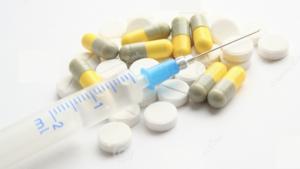
Treatment options for PRP
There is no cure for PRP. Therefore, the goal of treatment is to relieve the symptoms.
According to the National Organization of Rare Diseases: “PRP tends to follow a natural waxing and waning course, with episodes in which there is periodic worsening (exacerbation) or cessation (remission) of symptoms.” Source: NORD PRP Report
From the PRP perspective, there are two major objectives in the treatment of pityriasis rubra pilaris:
✽ relieving symptoms as they present
✽ achieving long-term remission, if possible
The mantra heard within the PRP community is simple but deafening: “What works for one doesn’t work for all.”
TREATMENT OPTIONS
 Oral retinoids are derivatives of vitamin A that slow the growth and shedding of skin cells.
Immunosuppressants to slow down the body’s immune system. Often used when oral retinoids are ineffective.
Biologicals with generally fewer side effects, targeted to reduce inflammation. These are injectable or intravenous (IV) medications that affect the immune system.
Oral retinoids are derivatives of vitamin A that slow the growth and shedding of skin cells.
Immunosuppressants to slow down the body’s immune system. Often used when oral retinoids are ineffective.
Biologicals with generally fewer side effects, targeted to reduce inflammation. These are injectable or intravenous (IV) medications that affect the immune system.
- adalimumab/Humira
- brodalumab/Silliq
- certolizumab/Cimzia
- dupilmab/Dupixent
- etanercept/Enbrel
- golimumab/Simponi
- guselkumab/Tremfya
- infliximab/Remicade
- ixekizumab/Taltz
- risankizumab/Skyrizi
- secukinumab/Cosentyx
- ustekinumab/Stelara
- upadacitinib/Rinvoq
Additional therapies
OTHER CONSIDERATIONS
- No meds at all is an option taken by PRP patients concerned with the negative impact of side effects.
- Lab tests to monitor the effects of medications on the body and efficient management of drug side effects are important follow-up issues that will concern PRP patients and caregiver who is under a doctor’s care.
- Access to treatment options varies based on age, geography, cost and FDA approval.
COMPLIMENTARY HEALTH OPTIONS
- What are the issues related to a Complementary Health approach?
- Things to know when selecting a Complementary Health option
- What do I need to know about acupuncture?
